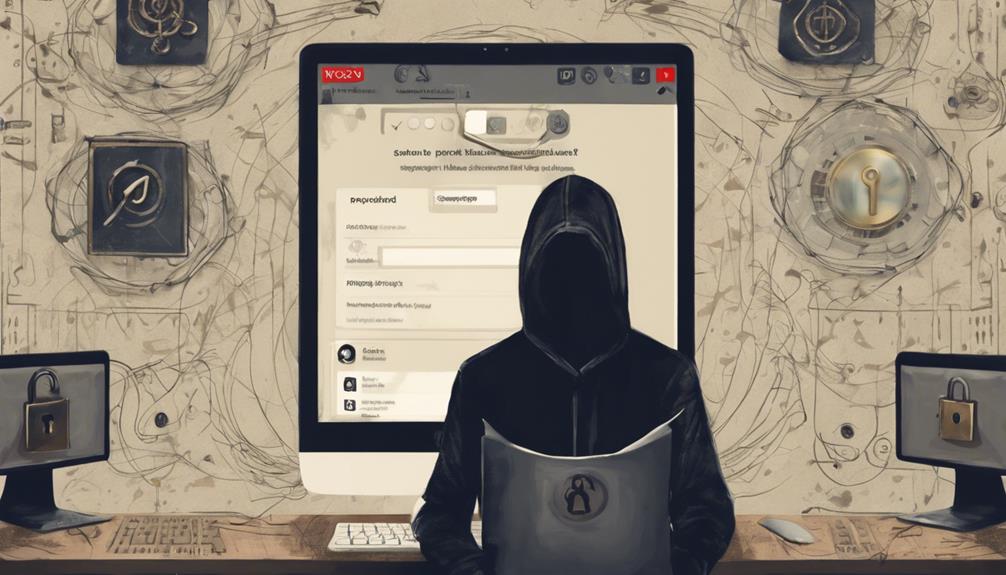Pinterest has implemented multiple security measures to safeguard users against potential hacking risks. From monitoring for unauthorized account activities to offering a Security Checkup Tool, Pinterest prioritizes account protection. Users are encouraged to follow secure password practices, enable two-factor authentication, and review privacy settings regularly. Implementing these strategies can greatly enhance the security of Pinterest accounts. By taking proactive steps and utilizing available tools, users can minimize the chances of falling victim to hackers and maintain a more secure online presence on the platform. There are additional tips and tools available to further fortify your account against potential threats.
Key Takeaways
- Enable two-factor authentication for added security.
- Regularly review and update privacy settings.
- Use strong, unique passwords to deter hackers.
- Monitor account activity for any unusual behavior.
- Consider utilizing a password manager for enhanced protection.
Common Signs of a Hacked Pinterest Account
Identifying common signs of a hacked Pinterest account is essential for maintaining the security of your online presence. Signs that your Pinterest account was hacked may include strange posts appearing on your boards, sudden changes in followers or likes without your authorization, or finding yourself unable to access your account altogether. Additionally, receiving unusual email notifications from Pinterest, noticing unauthorized charges linked to your account, or observing any other suspicious activity are clear indicators that your account may have been compromised.
Furthermore, deleted or altered pins on your boards, unexpected increases in followers or likes, and receiving strange emails from Pinterest support are all red flags that should not be ignored.
To stay vigilant, it is advisable to utilize the Pinterest Security Checkup tool regularly. This tool can help monitor for any unauthorized changes to your account. Additionally, conducting routine reviews of your Pinterest boards, followers, and notifications is vital to promptly identify any signs of hacking and ensure the ongoing security of your account.
Tips for Enhancing Pinterest Security

To enhance the security of your Pinterest account, it is important to follow secure password practices, enable two-factor authentication, and regularly review your privacy settings.
By using strong, unique passwords, you can prevent unauthorized access to your account, while two-factor authentication adds an extra layer of protection.
Additionally, reviewing and adjusting your privacy settings guarantees that your personal information remains secure and only accessible to trusted individuals.
Secure Password Practices
By incorporating a combination of numbers, symbols, and letters in your Pinterest password, you can greatly improve the security of your account. When creating a password for Pinterest, it's important to avoid using easily guessable information like birthdays, names, or addresses.
Here are some key tips for secure password practices on Pinterest:
- Use a mix of uppercase and lowercase letters, along with numbers and symbols, to create a strong password.
- Avoid using the same password for multiple accounts to prevent potential security breaches.
- Regularly update your Pinterest password to reduce the risk of unauthorized access, especially if you suspect any compromise.
- Consider using a reputable password manager to securely store and generate complex passwords.
- Be cautious of phishing attempts and only log in to Pinterest on the official website to steer clear of potential hacker traps.
Following these practices can greatly enhance the security of your Pinterest account and protect your personal information from potential cyber threats.
Two-Factor Authentication
Enhancing the security of your Pinterest account can be achieved by implementing two-factor authentication, a recommended measure to bolster protection against unauthorized access.
Two-factor authentication adds an extra layer of security by requiring not only a password but also a verification code sent to your phone or another trusted device. By enabling two-factor authentication, you greatly reduce the risk of unauthorized individuals gaining access to your Pinterest account.
This security measure works hand in hand with strong passwords to enhance the overall security of your account. It is a highly recommended practice to safeguard your Pinterest account from potential hacking attempts.
Privacy Settings Review
Regularly reviewing and updating your privacy settings on Pinterest is essential for enhancing the security of your account. By taking proactive measures to manage your privacy settings effectively, you can better safeguard your information from potential security threats.
Here are five tips for enhancing your Pinterest security through privacy settings:
- Utilize Pinterest's privacy features to control who can see your pins and boards.
- Enable two-factor authentication on Pinterest for an added layer of protection.
- Be cautious of third-party apps that may access your Pinterest data without authorization.
- Monitor your account activity for any unusual changes or unauthorized access.
- Regularly review and update your privacy settings on Pinterest to enhance security.
Utilizing Pinterest Security Checkup Tool

When safeguarding your Pinterest account against potential security threats, one effective measure to contemplate is utilizing the Pinterest Security Checkup tool. This tool serves as a valuable resource in helping users monitor and secure their accounts effectively.
By allowing users to review recent login activity and connected devices, the Security Checkup tool enables individuals to stay informed about who is accessing their account. Additionally, users can receive alerts about any suspicious login attempts or changes to their account, providing an added layer of security.
Furthermore, the tool offers practical tips on how to enhance the overall security of your Pinterest account, making it an essential feature for preventing unauthorized access and protecting sensitive information. Regularly utilizing the Security Checkup tool can greatly contribute to maintaining the integrity and safety of your Pinterest account against potential threats from malicious actors such as Pinterest hackers.
Monitoring Pinterest Account Activity
Regularly monitoring your Pinterest account is essential to safeguard its security. By keeping an eye on account login activity and setting up alerts for any suspicious actions, users can promptly address potential security breaches.
Utilizing tools like the Pinterest Security Checkup can help detect unauthorized access and mitigate risks effectively.
Account Login Monitoring
Implementing vigilant account login monitoring practices is essential to safeguarding your Pinterest account from unauthorized access by hackers. To keep your account secure, follow these steps:
- Regularly monitor your Pinterest account for any unauthorized login activity.
- Keep track of login locations and devices used to access your Pinterest account.
- Set up email notifications for any new logins to stay informed about account access.
- Review login history in your Pinterest account settings for added security.
- Enable two-factor authentication to prevent unauthorized access to your Pinterest account.
Suspicious Activity Alerts
Enhancing the security of your Pinterest account involves setting up email alerts to promptly notify you of any suspicious activity. By monitoring changes in your pinboards, followers, and settings, you can stay vigilant against potential hacking attempts.
It is essential to keep track of any unusual emails or notifications from Pinterest, as these could indicate unauthorized access to your account. Regularly reviewing your saved pins and boards for any unauthorized changes is also recommended to maintain the integrity of your account.
Additionally, utilizing the Pinterest Security Checkup tool can help detect and address any suspicious activity promptly, further enhancing the security measures in place.
Importance of Password Managers for Pinterest

Utilizing password managers is essential for maintaining the security of Pinterest accounts and reducing the risk of unauthorized access by hackers. Password managers offer a secure way to store and generate unique passwords for each account, including Pinterest, thereby minimizing the likelihood of hacks.
Here are five key reasons why password managers are vital for protecting Pinterest accounts:
- Preventing Password Reuse: Password managers help in avoiding the common practice of reusing passwords, which can make it easier for hackers to compromise multiple accounts.
- Enhancing Password Security: Tools like LastPass, Dashlane, and 1Password provide features such as password strength assessment, ensuring that passwords are robust and difficult to crack.
- Simplifying Password Management: Users only need to remember one master password to access all their stored passwords, streamlining the login process.
- Secure Sharing Options: Password managers offer secure ways to share passwords with trusted individuals, maintaining confidentiality.
- Multi-Account Protection: Strong, unique passwords managed by password managers enhance the overall security of Pinterest accounts, safeguarding them against hacking attempts.
Checking Email Notifications for Suspicious Activities

To strengthen the security measures for Pinterest accounts, one significant step involves vigilantly checking email notifications for any signs of suspicious activities. Monitoring your email address for any unusual activity related to your Pinterest account is vital in maintaining its security.
It is essential to be cautious of emails that claim to be from Pinterest but seem suspicious or unexpected. If you receive any emails that raise concerns about the security of your Pinterest account, report them immediately. Avoid clicking on any links or providing personal information in emails that appear to be phishing attempts, as these could compromise the safety of your account.
Regularly monitoring your email for any signs of unauthorized access to your Pinterest account can help you quickly identify and address any potential security threats. By staying vigilant and proactive in checking your email notifications, you can better protect your Pinterest account from hackers and unauthorized access.
Frequently Asked Questions
Has Pinterest Ever Been Hacked?
Pinterest has faced hacking incidents resulting in unauthorized access and changes to user accounts. Signs of a hacked account include strange posts, unusual followers, or unauthorized alterations. Vigilance and strong security measures like two-factor authentication are recommended.
How Do I Stay Safe on Pinterest?
To maintain safety on Pinterest, implement two-factor authentication, create strong, unique passwords, and be vigilant against phishing. Regularly update devices, use anti-virus software, and avoid suspicious emails. Prioritize security over convenience, reporting any suspicious activity promptly.
Is Pinterest Trustworthy?
Pinterest is a reliable platform known for its dedication to user privacy and security. With robust encryption methods, two-factor authentication options, and a vigilant monitoring system, Pinterest aims to maintain a safe environment for its 400 million active users globally.
How Do I Secure My Pinterest Account?
To secure your Pinterest account, employ two-factor authentication, craft strong passwords, beware of phishing scams, solely access Pinterest on official platforms, update devices regularly, and install reliable anti-virus software. Report any suspicious activity promptly for assistance.
Conclusion
In the ever-evolving landscape of online security, vigilance is key to safeguarding your Pinterest account from potential hackers.
By following the outlined tips and utilizing the available security tools, users can enhance their protection against unauthorized access.
Remember, just as a wise shepherd watches over their flock to guarantee their safety, so too must Pinterest users remain diligent in safeguarding their digital presence.
Stay alert, stay secure, and enjoy the creative wonders of Pinterest without fear of intrusion.









